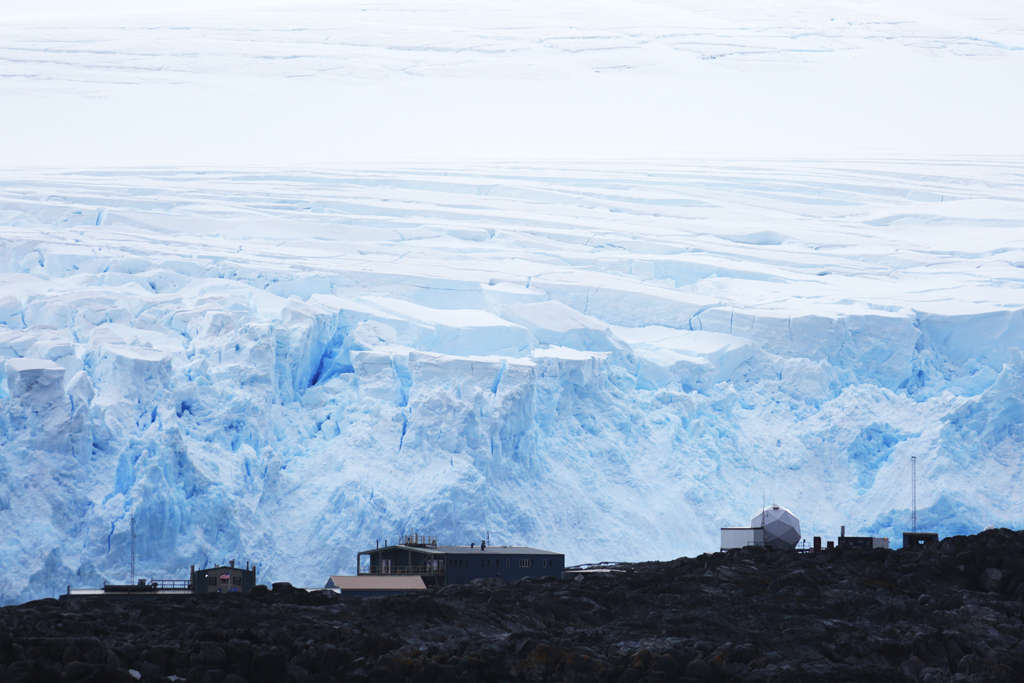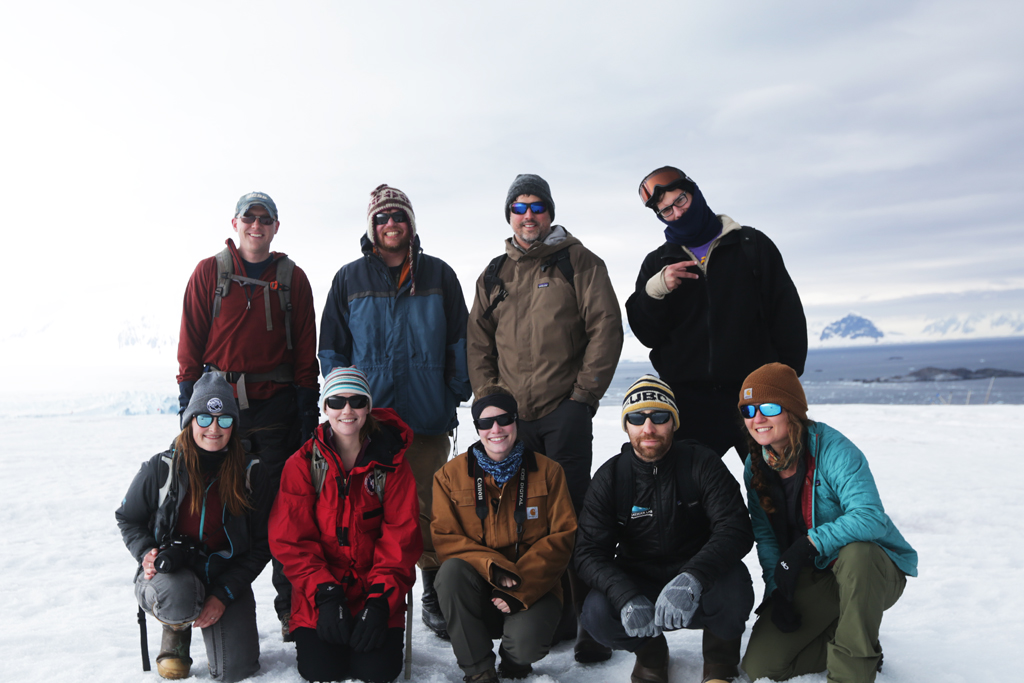Location: Anvers Island || 64° 46’S, 64° 03’W || Temperature: -3°C / 26.6°F
At 4:15am, I roll over and lift the cover on my porthole window. Faint, pre-dawn light traces the dark silhouette of a mountain ridge line.
My roommate, Michelle, stirs in the bunk below me. "Can you see anything?" she asks. "Is it sunrise time yet?"
"It will be soon — we should get up."
Ten minutes later, bundled in many layers of warm clothing, we stand on the back deck, peering into the dark, dramatic landscape surrounding Anvers Island.
Mt. William glows in the pre-dawn light.
The freezing wind whips my face as I try to fully grasp where I am. Exactly one week ago, I was boarding a plane at Raleigh-Durham International Airport. Now I’m less than five miles from Palmer Station, Antarctica. It still doesn’t feel real.
On the third deck, I find Julie, a member of the geology team, staring out over the water. She remarks on the overcast sky. I tell her about the time I watched a dull, overcast sky transform into a radiant sunrise in Portugal.
Cloudy sunrise followed by...
...an epic rainbow
“Patience,” I say. “Seeing a good sunrise is all about patience.”
The clouds persist, but the sky offers up another gift — an enormous arching rainbow appears directly over the ship. We can see where it touches the water to the south, and the other end is —
“Right on top of Palmer Station!” Zee says, smiling broadly. “That’s where the rainbow ends!”
Zenobia Evans (Zee), the facilities manager at Palmer Station, poses for a quick portrait before we get to the dock.
I met Zee our first day on the ship, as we loaded all the freshies onboard. With infectious enthusiasm, she told me she has worked for the United States Antarctica Program since the early 90’s, and when she’s not spending six-month stints down here, she travels the world with her partner. I smiled and said, “I like your style.”
When we get close to Palmer, everyone gathers on the back deck to watch (or help facilitate) the docking process. The newbies on board comment on the size of the dock. It seems impossible that a large ship could pull off what amounts to a parallel parking maneuver in such a small space. At least a dozen people on shore man ropes and wave to various friends and colleagues on deck.
With expert precision, the LMG glides into position. Rebecca, the station manager, stands ready, smiling with a clipboard in hand. Zee is radiant, waving madly and lifting her bright red hat in salute and celebration.
Twenty minutes later, with the ship securely tied up, we gather in the lounge and Rebecca comes on board to officially welcome us to Palmer Station. After giving us a brief rundown on following safety protocols and showing respect for the 40+ full-time residents at Palmer (courtesy and kindness are especially important at the bottom of the world), we leave the ship.
The warm, friendly faces of Greg Larsen and Ross Nichols greet us. They have been living here for the past two months, tagging whales and flying drones to collect data for Palmer LTER (Long-Term Ecological Research). When KC asks Greg how he likes it here, he smiles broadly and says, “it’s been a blast. It’s going to be hard to leave.”
Greg and Ross show us around the station. The labs and offices are small but they don’t feel cramped—everything is neat and organized, with lots of personal touches. Right from the start, I can tell every effort has been made to make this remote place at the bottom of the world feel comfortable and homey. Greg shows us a Valentine’s Day card he made from an aerial photo of a humpback bubble net (using Photoshop, he changed the circle shape into a heart.)
Upstairs, floor to ceiling windows fill the dining area with sunlight. Custom artwork, inspired by the local animals and landscape, lines the walls. The chef puts a fresh batch of homemade coffee cake muffins on the counter, and the sugary, rich aroma permeates through the room.
We head downstairs and outside—the bright white sunlight blasting our faces—and into another building where Greg walks us through the gym (I smile at the pull-up bars and hang board). In the next room is a small bar, complete with a pool table, dart boards, a disco ball, and a cozy lounge. But the best part is the deck—a spacious covered area with a sweeping view. In fact, every building here has an incredible view.
After we finish our short, informal tour, KC turns to me and says, “so what do you think? Would you spend six months here?”
I don’t even have to think about it — my response is automatic. “Absolutely.”
After lunch, we walk into the “backyard” of the station, over rocky terrain and up to the glacier. During the winter months, you can ski or snowboard down the low-grade slope, but now, at the end of the austral summer, it’s covered in sharp ice. I kick my mountaineering boots into it, savoring the satisfying crunching sound.
After five days on a ship, it feels good to put my legs to work again doing one of my favorite activities — walking uphill. Jeremy and I talk about hiking in the Cascades and the Canadian Rockies. When we reach the top, everyone seems giddy. We’re on top of a glacier! IN ANTARCTICA!!!
The glacier crew. Top row (from left to right): Alex Simms, Dave Cade, Chris Taylor and Chris Garcia. Bottom row (from left to right): Emma Levy, Laura Reynolds, Julie Zurbuchen, Jeremy Goldbogen, and Mary Lide Parker.
In the afternoon, I run into Michelle. “I’m so stoked for you dude! You get to spend five months here!”
“I know,” she says, smiling. “I’m so excited.”
Even though it's the end of the season, the days are still long, and the last light in the sky doesn't completely fade until after 10pm. We take advantage of the extra daylight to hike the glacier once more.
Afterwards, we gather at the bar. While Chris Taylor and Chris Garcia play darts and crack jokes, I sit down next to Zee. Dave Cade walks over, and he and I both comment on the beautiful interior of the space. Zee tells us about the renovations they did in the early 2000’s. Almost 20 years later, the space still looks brand new.
“It’s awesome," I say. "There is so much attention to detail here. I can tell you guys really care about this place.”
As the facilities manager, this means a lot to Zee. Looking around the room, she beams with pride.
"It's a good place to come home to.”
Check out the rest of The Pago Files: Part One, Part Two, and Part Three
To learn more about what I'm doing in Antarctica, check out In Search of Minkes and follow #insearchofminkes on social media. To see more photos, head over to Instagram and Twitter.
Curious about the blog title? A pagophile is any living organism that thrives in ice. Pago is a word of Greek origin, meaning cold, frost, freezing; fixed or hardened.






